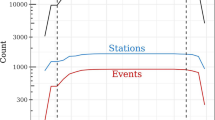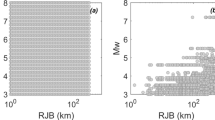Abstract
One of the major challenges related with the current practice in seismic hazard studies is the adjustment of empirical ground motion prediction equations (GMPEs) to different seismological environments. We believe that the key to accommodating differences in regional seismological attributes of a ground motion model lies in the Fourier spectrum. In the present study, we attempt to explore a new approach for the development of response spectral GMPEs, which is fully consistent with linear system theory when it comes to adjustment issues. This approach consists of developing empirical prediction equations for Fourier spectra and for a particular duration estimate of ground motion which is tuned to optimize the fit between response spectra obtained through the random vibration theory framework and the classical way. The presented analysis for the development of GMPEs is performed on the recently compiled reference database for seismic ground motion in Europe (RESORCE-2012). Although, the main motivation for the presented approach is the adjustability and the use of the corresponding model to generate data driven host-to-target conversions, even as a standalone response spectral model it compares reasonably well with the GMPEs of Ambraseys et al. (Bull Earthq Eng 3:1–53, 2005), Akkar and Bommer (Seismol Res Lett 81(2):195–206, 2010) and Akkar and Cagnan (Bull Seismol Soc Am 100(6):2978–2995, 2010).


















Similar content being viewed by others
References
Abrahamson NA, Silva WJ (1997) Empirical response spectral attenuation relation for shallow crustal earthquakes. Seismol Res Lett 68(1):94–127. doi:10.1785/gssrl.68.1.94
Abrahamson NA, Youngs RR (1992) A stable algorithm for regression analyses using the random effects model. Bull Seismol Soc Am 82(1):505–510
Ambraseys NN, Douglas J, Sarma SK, Smit PM (2005) Equations for estimation of strong ground motions from shallow crustal earthquakes using data from Europe and the Middle East: horizontal peak ground acceleration and spectral acceleration. Bull Earthq Eng 3:1–53. doi:10.1007/s10518-005-0183-0
Akkar S, Bommer JJ (2006) Influence of long-period filter cut-off on elastic spectral displacements. Earthq Eng Struct Dyn 35:1145–1165
Akkar S, Bommer JJ (2010) Empirical equations for the prediction of PGA, PGV, and spectral accelerations in Europe, the Mediterranean region and the Middle East. Seismol Res Lett 81(2):195–206
Akkar S, Cagnan Z (2010) A Local ground-motion predictive model for Turkey, and its comparison with other regional and global ground-motion models. Bull Seismol Soc Am 100(6):2978–2995. doi:10.1785/0120090367
Akkar S, Kale Ö, Yenier E, Bommer JJ (2011) The high-frequency limit of usable response spectral ordinates from filtered analogue and digital strong-motion accelerograms. Earthq Eng Struct Dyn 40:1387–1401
Akkar S, Sandikkaya MA, Senyurt M, Azari SA, Ay BÖ (2013) Reference database for seismic ground-motion in Europe (RESORCE). Bull Eq Eng submitted to the same issue
Arias A (1970) A measure of earthquake intensity. In: Hansen R (ed) Seismic design for nuclear power plants. MIT Press, Cambridge, pp 438–483
Atkinson GM, Boore DM (1995) Ground motion relations for Eastern North America. Bull Seismol Soc Am 85(1):17–30
Atkinson GM, Mereu RF (1992) The shape of ground motion attenuation curves in Southeastern Canada. Bull Seismol Soc Am 82(5):2014–2031
Bommer JJ, Martinez-Pereira A (1999) The effective duration of earthquake strong motion duration. J Earthq Eng 3(2):127–172
Bommer JJ, Stafford PJ, Alarcon JE (2009) Empirical equations for the prediction of the significant, bracketed, and uniform duration of earthquake ground motion. Bull Seismol Soc Am 99(6):3217–3333
Boore DM (2003) Simulation of ground motion using the stochastic method. Pure Appl Geophys 160:635–676
Boore DM, Bommer JJ (2005) Processing of strong-motion accelerograms: needs, options and consequences. Soil Dyn Earthq Eng 25:93–115
Boore DM, Joyner WB (1984) A note on the use of random vibration theory to predict peak amplitudes of transient signals. Bull Seismol Soc Am 74(5):2035–2039
Boore DM, Thompson EM (2012) Empirical improvements for estimating earthquake response spectra with random-vibration theory. Bull Seismol Soc Am 102(2):761–772
Brune J (1970) Tectonic stress and the spectra of seismic shear waves from earthquakes. J Geophys Res 75(26):4997–5009
Campbell WK (2003) Prediction of strong ground motion using the hybrid empirical method and its use in the development of ground-motion (attenuation) relations in Eastern North America. Bull Seismol Soc Am 93(3):1012–1033
Campbell WK (2004) Erratum to Prediction of strong ground motion using the hybrid empirical method and its use in the development of ground-motion (attenuation) relations in Eastern North America. Bull Seismol Soc Am 94(6):2418
Cartwright DE, Longuet-Higgins MS (1956) The statistical distribution of the maxima of a Random function. Proc R Soc Lond Ser A Math Phys Sci 237(1209):212–232
Douglas J (2003) earthquake ground motion estimation using strong-motion records: a review of equations for the spectral ordinates. Earth Sci Rev 61:43–104
Douglas J (2011) Ground motion prediction equations 1964–2010. Final report BRGM/RP-59356-FR
Douglas J, Boore DM (2011) High-frequency filtering of strong-motion records. Bull Earthq Eng 9:395–409
Hanks TC, McGuire RK (1981) The character of high-frequency strong ground motion. Bull Seismol Soc Am 71:2071–2095
Hermann RB (1985) An extension of random vibration theory estimates of strong ground motion to large distances. Bull Seismol Soc Am 75(5):1447–1453
Jaimes MA, Reinoso E, Ordaz M (2006) Comparison of methods to predict response spectra at intsrumented sites given the magnitude and distance of an earthquake. J Earthq Eng 10(6):887–902
Kempton JJ, Stewart JP (2006) Prediction equations for significant duration of earthquake ground motions consideringsiteandnear-sourceeffects. Earthq Spectra 22(4):985–1013
Liu L, Pezeshk S (1999) An improvement on the estimation of Pseudoresponse spectral velocity using RVT method. Bull Seismol Soc Am 89(5):1384–1389
McGuire R (1978) A simple model for estimating Fourier amplitude spectra of horizontal ground acceleration. Bull Seismol Soc Am 68(3):803–822
Reinoso E, Ordaz M, Sanchez-Sesma FJ (1990) A note on the fast computation of response spectra estimates. Earthq Eng Struct Dyn 19:971–976
Simons FJ, Hilst RD, Zuber MT (2003) Spatiospectral localization of isostatic coherence anisotropy in Australia and its relation to seismic anisotropy: implications for lithospheric deformation. J Geophys Res 108(B5):2250. doi:10.1029/2001JB000704
Sokolov V, Chin-hsiung L, Kuo-liang W (2000) Empirical model for estimating Fourier amplitude spectra of ground acceleration in Taiwan region. Earthq Eng Struct Dyn 29:339–357
Spudich P, Joyner WB, Lindh AG, Boore DM, Margaris BM, Fletcher JB (1999) SEA99: a revised ground motion prediction relation for use in extensional tectonic regimes. Bull Seismol Soc Am 89(5):1156–1170
Stafford PJ (2006) Engineering seismological studies and seismic design criteria for the Buller region, Ph.D Thesis. University of Canterbury, South Island, New Zealand
Stafford PJ, Berill J, Pettinga J (2006) New empirical equations for the Fourier amplitude spectrum of acceleration and Arias intensity in New Zealand. In: Proceedings of First European conference on earthquake engineering and seismology
Trifunac MD (1976) Preliminary empirical model for scaling Fourier amplitude spectra of strong ground acceleration in terms of earthquake magnitude, source-to-site distance, and recording site conditions. Bull Seismol Soc Am 66(4):1343–1373
Vanmarcke EH, Lai SP (1980) Strong motion duration and rms amplitude of earthquake records. Bull Seismol Soc Am 70(4):1293–1307
Acknowledgments
Sanjay Singh Bora would like to thank Helmholtz graduate research school GeoSim (http://www.geo-x.net/geosim) for providing a scholarship. Present analysis of developing GMPEs is based on a dataset taken from the RESORCE database which is compiled under the framework of SeIsmic Ground Motion Assessment (SIGMA) project. We also thank two anonymous reviewers for their suggestions and comments which were helpful in improving the manuscript and bringing it to the present form.
Author information
Authors and Affiliations
Corresponding author
Rights and permissions
About this article
Cite this article
Bora, S.S., Scherbaum, F., Kuehn, N. et al. Fourier spectral- and duration models for the generation of response spectra adjustable to different source-, propagation-, and site conditions. Bull Earthquake Eng 12, 467–493 (2014). https://doi.org/10.1007/s10518-013-9482-z
Received:
Accepted:
Published:
Issue Date:
DOI: https://doi.org/10.1007/s10518-013-9482-z




